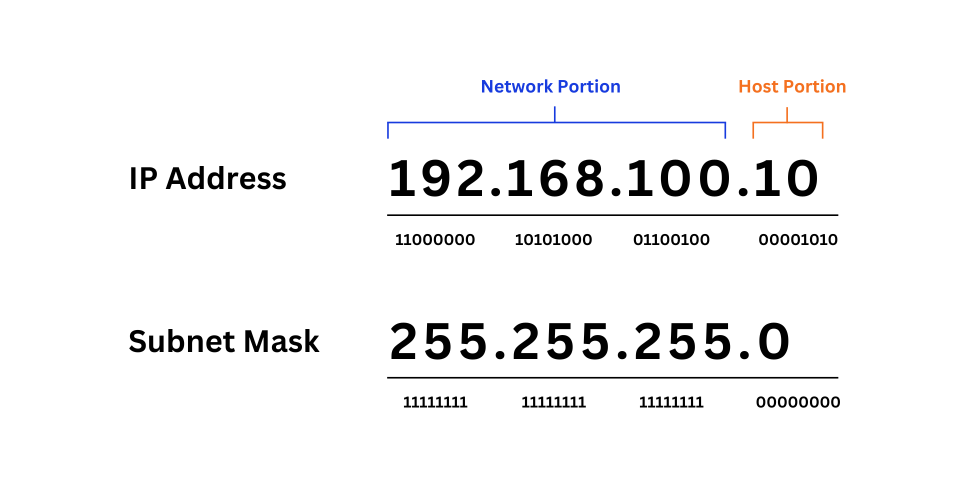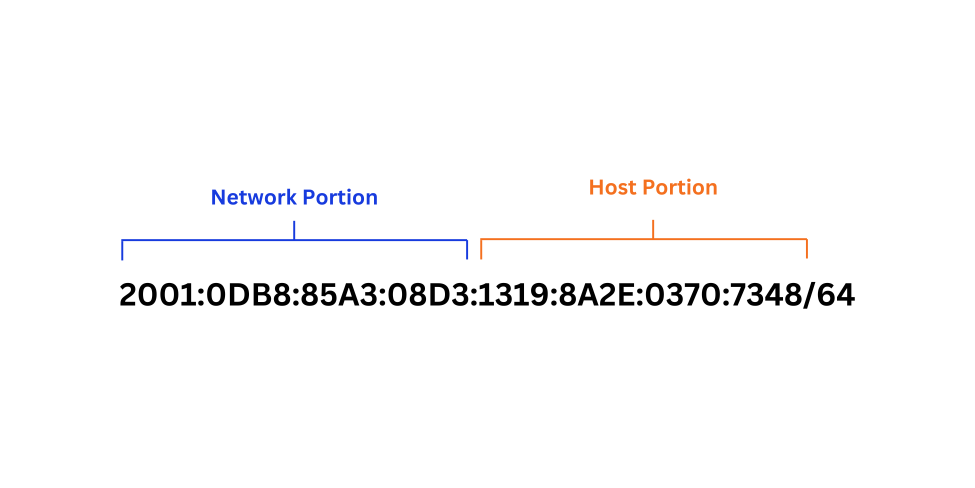
Introduction to CIDR
Classless Inter-Domain Routing (CIDR) is an IP address allocation technique designed to enhance data routing efficiency across the internet. CIDR enables the representation of IP addresses in a more scalable way. Therefore, this helps to prevent the rapid exhaustion of IPv4 addresses.
This article provides a IPv4 and IPv6 CIDR table, explaining subnet masks for IPv4 and subnetting concepts for IPv6, along with practical examples for easy reference.
Understanding Subnet Masks in IPv4
A subnet mask in IPv4 is a 32-bit number that divides an IP address into network and host portions. The network portion identifies the specific network where the host portion identifies individual devices within that network. The first 24 bits (corresponding to the 1s in the subnet mask) represent the network address, while the remaining 8 bits (corresponding to the 0s in the subnet mask) represent the host address.
For example, in the IP address 192.168.100.10, the first three octets (192.168.10) represent the network portion, while the final octet (10) represents the host portion.

IPv4 CIDR Table
In IPv4, subnetting allows a large network to be divided into smaller, manageable segments. This table shows the number of bits used for nodes, CIDR notation, subnet mask and the number of IP addresses that can be used for hosts.
| Bits | CIDR | Subnet Mask | IP Addresses |
|---|---|---|---|
| 0 | /32 | 255.255.255.255 | 1 |
| 1 | /31 | 255.255.255.254 | 2 |
| 2 | /30 | 255.255.255.252 | 4 |
| 3 | /29 | 255.255.255.248 | 8 |
| 4 | /28 | 255.255.255.240 | 16 |
| 5 | /27 | 255.255.255.224 | 32 |
| 6 | /26 | 255.255.255.192 | 64 |
| 7 | /25 | 255.255.255.128 | 128 |
| 8 | /24 | 255.255.255.0 | 256 |
| 9 | /23 | 255.255.254.0 | 512 |
| 10 | /22 | 255.255.252.0 | 1,024 |
| 11 | /21 | 255.255.248.0 | 2,048 |
| 12 | /20 | 255.255.240.0 | 4,096 |
| 13 | /19 | 255.255.224.0 | 8,192 |
| 14 | /18 | 255.255.192.0 | 16,384 |
| 15 | /17 | 255.255.128.0 | 32,768 |
| 16 | /16 | 255.255.0.0 | 65,536 |
| 17 | /15 | 255.254.0.0 | 131,072 |
| 18 | /14 | 255.252.0.0 | 262,144 |
| 19 | /13 | 255.248.0.0 | 524,288 |
| 20 | /12 | 255.240.0.0 | 1,048,576 |
| 21 | /11 | 255.224.0.0 | 2,097,152 |
| 22 | /10 | 255.192.0.0 | 4,194,304 |
| 23 | /9 | 255.128.0.0 | 8,388,608 |
| 24 | /8 | 255.0.0.0 | 16,777,216 |
| 25 | /7 | 254.0.0.0 | 33,554,432 |
| 26 | /6 | 252.0.0.0 | 67,108,864 |
| 27 | /5 | 248.0.0.0 | 134,217,728 |
| 28 | /4 | 240.0.0.0 | 268,435,456 |
| 29 | /3 | 224.0.0.0 | 536,870,912 |
| 30 | /2 | 192.0.0.0 | 1,073,741,824 |
| 31 | /1 | 128.0.0.0 | 2,147,483,648 |
| 32 | /0 | 0.0.0.0 | 4,294,967,296 |
You can convert a CIDR block to an IP range or vice versa to streamline the process of subnetting, routing, and optimizing IP address allocation within a network.
IPv4 Subnet Mask Examples
- /24 (255.255.255.0): Common for small to medium-sized networks, providing 254 usable host addresses.
- /16 (255.255.0.0): Suitable for larger networks, offering 65,534 usable host addresses.
- /30 (255.255.255.252): Ideal for point-to-point connections, providing only two usable host addresses.
Understanding Subnetting in IPv6
IPv6 subnetting is designed to be simpler and more efficient. With its larger address space which is 128-bit, network segmentation focuses less on conserving limited addresses (as in IPv4) and more on logical organization.
Most IPv6 addresses are /64 addresses, but this is not fixed. Instead of using subnet masks, IPv6 relies solely on CIDR notation to define network and subnet boundaries.
In a /64 IPv6 address, the first 4 hextets (64 bits) represent the network portion and the remaining 64 bits represent host portion.

IPv6 CIDR Table
This table shows the number of bits used, CIDR notation and the number of IP addresses that can be used for hosts.
| Bits | CIDR | IP Addresses |
|---|---|---|
| 0 | /128 | 1 |
| 1 | /127 | 2 |
| 2 | /126 | 4 |
| 3 | /125 | 8 |
| 4 | /124 | 16 |
| 5 | /123 | 32 |
| 6 | /122 | 64 |
| 7 | /121 | 128 |
| 8 | /120 | 256 |
| 9 | /119 | 512 |
| 10 | /118 | 1,024 |
| 11 | /117 | 2,048 |
| 12 | /116 | 4,096 |
| 13 | /115 | 8,192 |
| 14 | /114 | 16,384 |
| 15 | /113 | 32,768 |
| 16 | /112 | 65,536 |
| 17 | /111 | 131,072 |
| 18 | /110 | 262,144 |
| 19 | /109 | 524,288 |
| 20 | /108 | 1,048,576 |
| 21 | /107 | 2,097,152 |
| 22 | /106 | 4,194,304 |
| 23 | /105 | 8,388,608 |
| 24 | /104 | 16,777,216 |
| 25 | /103 | 33,554,432 |
| 26 | /102 | 67,108,864 |
| 27 | /101 | 134,217,728 |
| 28 | /100 | 268,435,456 |
| 29 | /99 | 536,870,912 |
| 30 | /98 | 1,073,741,824 |
| 31 | /97 | 2,147,483,648 |
| 32 | /96 | 4,294,967,296 |
| 33 | /95 | 8,589,934,592 |
| 34 | /94 | 17,179,869,184 |
| 35 | /93 | 34,359,738,368 |
| 36 | /92 | 68,719,476,736 |
| 37 | /91 | 137,438,953,472 |
| 38 | /90 | 274,877,906,944 |
| 39 | /89 | 549,755,813,888 |
| 40 | /88 | 1,099,511,627,776 |
| 41 | /87 | 2,199,023,255,552 |
| 42 | /86 | 4,398,046,511,104 |
| 43 | /85 | 8,796,093,022,208 |
| 44 | /84 | 17,592,186,044,416 |
| 45 | /83 | 35,184,372,088,832 |
| 46 | /82 | 70,368,744,177,664 |
| 47 | /81 | 140,737,488,355,328 |
| 48 | /80 | 281,474,976,710,656 |
| 49 | /79 | 562,949,953,421,312 |
| 50 | /78 | 1,125,899,906,842,620 |
| 51 | /77 | 2,251,799,813,685,248 |
| 52 | /76 | 4,503,599,627,370,496 |
| 53 | /75 | 9,007,199,254,740,992 |
| 54 | /74 | 18,014,398,509,481,984 |
| 55 | /73 | 36,028,797,018,963,968 |
| 56 | /72 | 72,057,594,037,927,936 |
| 57 | /71 | 144,115,188,075,855,872 |
| 58 | /70 | 288,230,376,151,711,744 |
| 59 | /69 | 576,460,752,303,423,488 |
| 60 | /68 | 1,152,921,504,606,846,976 |
| 61 | /67 | 2,305,843,009,213,693,952 |
| 62 | /66 | 4,611,686,018,427,387,904 |
| 63 | /65 | 9,223,372,036,854,775,808 |
| 64 | /64 | 18,446,744,073,709,551,616 |
| 65 | /63 | 36,893,488,147,419,103,232 |
| 66 | /62 | 73,786,976,294,838,206,464 |
| 67 | /61 | 147,573,952,589,676,412,928 |
| 68 | /60 | 295,147,905,179,352,825,856 |
| 69 | /59 | 590,295,810,358,705,651,712 |
| 70 | /58 | 1,180,591,620,717,411,303,424 |
| 71 | /57 | 2,361,183,241,434,822,606,848 |
| 72 | /56 | 4,722,366,482,869,645,213,696 |
| 73 | /55 | 9,444,732,965,739,290,427,392 |
| 74 | /54 | 18,889,465,931,478,580,854,784 |
| 75 | /53 | 37,778,931,862,957,161,709,568 |
| 76 | /52 | 75,557,863,725,914,323,419,136 |
| 77 | /51 | 151,115,727,451,828,646,838,772 |
| 78 | /50 | 302,231,454,903,657,293,676,544 |
| 79 | /49 | 604,462,909,807,314,587,353,088 |
| 80 | /48 | 1,208,925,819,614,629,174,706,176 |
| 81 | /47 | 2,417,851,639,229,258,349,412,352 |
| 82 | /46 | 4,835,703,278,458,516,698,824,704 |
| 83 | /45 | 9,671,406,556,917,033,397,649,408 |
| 84 | /44 | 19,342,813,113,834,066,795,298,816 |
| 85 | /43 | 38,685,626,227,668,133,590,597,632 |
| 86 | /42 | 77,371,252,455,336,267,181,195,264 |
| 87 | /41 | 154,742,504,910,672,534,362,390,528 |
| 88 | /40 | 309,485,009,821,345,068,724,781,056 |
| 89 | /39 | 618,970,019,642,690,137,449,562,112 |
| 90 | /38 | 1,237,940,039,285,380,274,899,124,224 |
| 91 | /37 | 2,475,880,078,570,760,549,798,248,448 |
| 92 | /36 | 4,951,760,157,141,521,099,596,496,896 |
| 93 | /35 | 9,903,520,314,283,042,199,192,993,792 |
| 94 | /34 | 19,807,040,628,566,084,398,385,987,584 |
| 95 | /33 | 39,614,081,257,132,168,796,771,975,168 |
| 96 | /32 | 79,228,162,514,264,337,593,543,950,336 |
| 97 | /31 | 158,456,325,028,528,675,187,087,900,672 |
| 98 | /30 | 316,912,650,057,057,350,374,175,801,344 |
| 99 | /29 | 633,825,300,114,114,700,748,351,602,688 |
| 100 | /28 | 1,267,650,600,228,229,401,496,703,205,376 |
| 101 | /27 | 2,535,301,200,456,458,802,993,406,410,752 |
| 102 | /26 | 5,070,602,400,912,917,605,986,812,821,504 |
| 103 | /25 | 10,141,204,801,825,835,211,973,625,643,008 |
| 104 | /24 | 20,282,409,603,651,670,423,947,251,286,016 |
| 105 | /23 | 40,564,819,207,303,340,847,894,502,572,032 |
| 106 | /22 | 81,129,638,414,606,681,695,789,005,144,064 |
| 107 | /21 | 162,259,276,829,213,363,391,578,010,288,128 |
| 108 | /20 | 324,518,553,658,426,726,783,156,020,576,256 |
| 109 | /19 | 649,037,107,316,853,453,566,312,041,152,512 |
| 110 | /18 | 1,298,074,214,633,706,907,132,624,082,305,024 |
| 111 | /17 | 2,596,148,429,267,413,814,265,248,164,610,048 |
| 112 | /16 | 5,192,296,858,534,827,628,530,496,329,220,096 |
| 113 | /15 | 10,384,593,717,069,655,257,060,992,658,440,192 |
| 114 | /14 | 20,769,187,434,139,310,514,121,985,316,880,384 |
| 115 | /13 | 41,538,374,868,278,621,028,243,970,633,760,768 |
| 116 | /12 | 83,076,749,736,557,242,056,487,941,267,521,536 |
| 117 | /11 | 166,153,499,473,114,484,112,975,882,535,043,072 |
| 118 | /10 | 332,306,998,946,228,968,225,951,765,070,086,144 |
| 119 | /9 | 664,613,997,892,457,936,451,903,530,140,172,288 |
| 120 | /8 | 1,329,227,995,784,915,872,903,807,060,280,344,576 |
| 121 | /7 | 2,658,455,991,569,831,745,807,614,120,560,689,152 |
| 122 | /6 | 5,316,911,983,139,663,491,615,228,241,121,378,304 |
| 123 | /5 | 10,633,823,966,279,326,983,230,456,482,242,756,608 |
| 124 | /4 | 21,267,647,932,558,653,966,460,912,964,485,513,216 |
| 125 | /3 | 42,535,295,865,117,307,932,921,825,928,971,026,432 |
| 126 | /2 | 85,070,591,730,234,615,865,843,651,857,942,052,864 |
| 127 | /1 | 170,141,183,460,469,231,731,687,303,715,884,105,728 |
| 128 | /0 | 340,282,366,920,938,463,463,374,607,431,768,211,456 |
You may download the pdf file of the IPv4 and IPv6 CIDR table.
IPv6 Subnetting Examples
- /64 Subnet: 2001:0db8:85a3::/64
- Usage: Ideal for a single LAN segment within an organization.
- Host Addresses: 18,446,744,073,709,551,616 possible addresses.
- /48 Subnet: 2001:0db8:85a3::/48
- Usage: Assigned to an enterprise, allowing them to create up to 65,536 /64 subnets.
- Host Addresses: Each /64 subnet provides an immense number of host addresses.
Practical Uses of CIDR Tables
Efficient Address Allocation
CIDR blocks help prevent waste of IP addresses by enabling networks to be allocated with just the number of addresses they need.
Simplified Routing
By aggregating routes, CIDR helps reduce the size of routing tables, enabling more efficient routing in large networks like the internet.
Network Security
In addition, CIDR allows for fine-grained control over IP ranges, making it easier to define firewall rules, network policies, and access control lists.
Subnetting
IPv4: Dividing a larger network into smaller subnets for organizational or security purposes.
IPv6: Creating standardized /64 subnets for individual LAN segments, facilitating features like SLAAC.
Conclusion
Understanding CIDR is essential for efficient IP address management, whether you’re working with IPv4 or the expansive IPv6. CIDR tables provide quick reference points for determining how many hosts a particular block can support and help you organize your networks at any scale. By utilizing subnet masks in IPv4 and embracing the streamlined subnetting approach in IPv6, you can manage IPs in a way that maximizes both resource availability and network performance.
